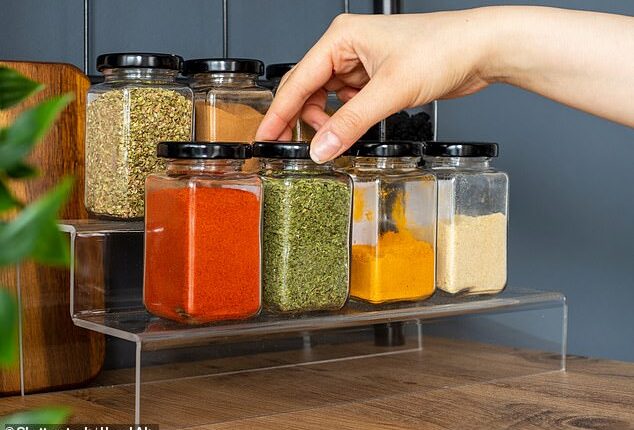Any home cook worth their salt will happily boast a cupboard full of spices that can turn the blandest of dishes into a delicious meal.
But experts say an overloaded spice rack is simply unnecessary.
Instead, according to Chef Max Posener, any kitchen only needs 12 dried herbs and spices.
Chef Posener, who has years of experience working in Michelin starred restaurants, including Ynyshir in Machynlleth, Wales, said that cumin, paprika and cinnamon are among the essentials needed.
The expert, who now runs Otaku, an 18 course supper club from his North home, revealed the 12 spices everyone should have in their kitchen (see box) as well as sharing tips on how to use them.
The spices you need – and how to use them

A chef has revealed the only 12 spices you need, as well as sharing tips on how best to use them (stock image)
Speaking to the Daily Mail, Max recommended that people don’t use spices in the cooking process, but instead turn the heat off and let it cool.
‘Once it’s stopped boiling, throw in different spices and infuse until ready to serve in order to keep them as fragrant and fresh as possible,’ he explained.
Next, Max suggested investing in a spice blender, saying: ‘Toast your spices whole and blend them, they will be far better than the store-bought stuff. Cumin, coriander, fennel, pepper. Know how to toast and bring out the aroma of your spices.
‘Do not over-toast. Everyone knows to toast their spices before using them, but most people don’t realise that you only need to very gently warm them until they’re fragrant before beginning the cooking process for any curry, etc.
‘The tendency is to toast them until you see colour, but this will burn them and make them overpower the curry you’re working with.’
Another way to get the most out of spices is to use them in an overnight infusion – especially when cooking desserts, if you don’t want to over spice your desserts.
Max explained: ‘Infuse cold overnight in your liquid in the fridge and strain off the next morning. Vanilla, Nutmeg, Tonka Bean for custard, Chamomile, Cloves for panna cotta, Cinnamon, Cardoman, Star Anise, for Rice pudding.
‘This will impart super floral notes in the background of your dishes without overpowering.’
Finally he said: ‘Do not think of spices as seasoning. Black pepper is not salt. Don’t season meat as you might with salt, certainly not at the start of your cooking process.

An important tip Chef Max Posener (pictured) shared was to err on the side of caution when adding spices, as you can always add, but can’t take away
‘It will just fall off and/or burn in your pan. It’s a spice – use it as such. And if you have to, season to taste at the table.
‘You can always add, but you can’t take away, so err on the side of caution.’
Chef’s favourites
The chef also shared his favourite spices, as well as suggesting how they can be used.
Tahitian vanilla – one of the most incredible products going. It can transform any dessert into one worthy of a Michelin star. Such a familiar flavour that everyone loves.
Tonka bean – lesser known but almost as aromatic as vanilla. It has vanilla and almond notes and is very, very versatile. It can be used for rice puddings, custards, panna cotta, poached fruit, ice cream, and pairs well with chocolate too.
Five spice – star anise, clove, cinnamon, fennel seed and Sichuan peppercorn. The spice mix is made for you, so you don’t even need to think about that. Holds up well with meats. Traditionally paired with Chinese Peking duck, but goes well with anything fatty that can also take a lot of sweetness: pork belly, beef ribs, chicken thighs. (Same goes for sumac.)
Curry powder (specifically S&B Japanese curry powder); combines turmeric, coriander, cumin, fenugreek and other spices into a fiery, sweet and punchy version of the curry powder familiar in the UK.

According to Chef Max, a great motto to bear in mind is that things that grow together often go together (stock image)
How to know what spices to use
Chef Max said people should ‘taste, taste, taste’, to try and get to know the spice you’re working with.
He added: ‘You will intuitively know much better what goes with what and how best to use it. If something is more aromatic and floral (vanilla, chamomile, cardamom), you’ll more than likely use these for infusions for desserts.
‘Pungent spices such as cumin and coriander can stand up against meats better than lighter floral spices like sumac, which can pair better with fish.’
Another tip was to think of your childhood, which Max said ‘always helps’ him. However, it’s not necessary to fret too much: according to the chef: ‘Everyone eats food and intuitively knows what goes with what. Everyone knows chamomile and honey are a match made in heaven.’
A great motto to bear in mind is that things that grow together often go together. Max said: ‘So look at the provenance of your spices and other ingredient.’
For example, Paprika (made from dried peppers), grows with tomatoes, basil and onions, while fennel grows in similar environments to dill, coriander and cumin – which is basically all you need for a great base for a curry according to Max.
‘And tonka bean grows with cacao in the rainforest,’ said the chef. ‘So no wonder it pairs so nicely with chocolate.’








